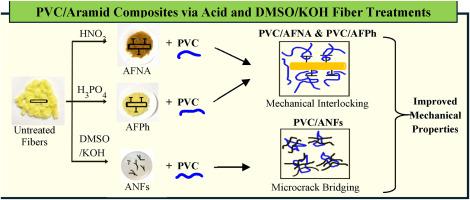纤维改性对芳纶纤维增强液铸聚氯乙烯薄膜力学性能的影响
IF 4.5
2区 化学
Q2 POLYMER SCIENCE
引用次数: 0
摘要
本文比较了三种纤维处理方法对芳纶纤维增强聚氯乙烯(PVC)的效果。其中两种分别使用磷酸和硝酸,硝酸是首次引入。酸蚀使纤维表面变得粗糙,增加了与PVC的摩擦和机械联锁。第三种方法是用二甲基亚砜(DMSO)/氢氧化钾(KOH)去质子化法处理纤维。本研究介绍了一种更简化的方法,省去了烷基功能化,有利于乙醇的沉淀。脱质子破坏了纤维中的晶体结构,并将其分解成芳纶纳米纤维(anf)。所有的处理程序都能显著提高复合材料的机械性能。与磷酸处理相比,硝酸处理可获得更高的抗拉强度和杨氏模量。含ANFs的复合材料抗拉强度最高。断口学揭示了酸处理纤维与ANFs复合材料之间不同的失效机制。酸处理纤维在材料破坏过程中出现界面分层,表明复合强度的增强主要是由于界面力的增强。相比之下,ANFs不像原始纤维那样承载载荷,但其较小的尺寸允许纳米级分散,这可以抑制变形过程中微裂纹的形成。我们对纤维处理方案的系统评估为在非反应性热塑性塑料系统中定制纤维-基质相互作用提供了关键见解,提高了柔性PVC在承载环境中的应用潜力。本文章由计算机程序翻译,如有差异,请以英文原文为准。

Effects of Fiber Modification on the Mechanical Properties of Solution-Cast Poly(vinyl chloride) Films Reinforced by Aramid Fibers
This study compared the effectiveness of three fiber treatment methods for reinforcing polyvinyl chloride (PVC) with aramid fibers. Two of them used phosphoric and nitric acids, respectively, the latter of which was introduced for the first time. Acid etching roughens the fiber surface for increased friction and mechanical interlocking with PVC. The third approach treated fibers with a dimethyl sulfoxide (DMSO)/potassium hydroxide (KOH) deprotonation procedure. A more streamlined procedure was introduced in this study which omitted alkyl functionalization in favor of ethanol precipitation. Deprotonation disrupts the crystalline structure in the fibers and unbundle them into aramid nanofibers (ANFs). All treatment procedures lead to substantial improvements in composite mechanical properties. Compared with phosphorous acid, treatment by nitric acid results in higher tensile strength and Young’s modulus. Composites with ANFs show highest tensile strength among all cases. Fractography reveals distinct failure mechanisms between composites with acid-treated fibers versus those with ANFs. The acid-treated fibers exhibit interfacial delamination during material failure, indicating that enhanced composite strength is mainly attributed to stronger interfacial forces. In contrast, ANFs do not carry load in the same way as the original fibers do, but their smaller dimensions allow nanoscale dispersion, which can suppress microcrack formation during deformation. Our systematic evaluation of fiber treatment options provides critical insights for tailoring fiber-matrix interactions in non-reactive thermoplastic systems, advancing the application potential of flexible PVC in load-bearing environments.
求助全文
通过发布文献求助,成功后即可免费获取论文全文。
去求助
来源期刊

Polymer
化学-高分子科学
CiteScore
7.90
自引率
8.70%
发文量
959
审稿时长
32 days
期刊介绍:
Polymer is an interdisciplinary journal dedicated to publishing innovative and significant advances in Polymer Physics, Chemistry and Technology. We welcome submissions on polymer hybrids, nanocomposites, characterisation and self-assembly. Polymer also publishes work on the technological application of polymers in energy and optoelectronics.
The main scope is covered but not limited to the following core areas:
Polymer Materials
Nanocomposites and hybrid nanomaterials
Polymer blends, films, fibres, networks and porous materials
Physical Characterization
Characterisation, modelling and simulation* of molecular and materials properties in bulk, solution, and thin films
Polymer Engineering
Advanced multiscale processing methods
Polymer Synthesis, Modification and Self-assembly
Including designer polymer architectures, mechanisms and kinetics, and supramolecular polymerization
Technological Applications
Polymers for energy generation and storage
Polymer membranes for separation technology
Polymers for opto- and microelectronics.
 求助内容:
求助内容: 应助结果提醒方式:
应助结果提醒方式:


